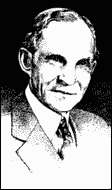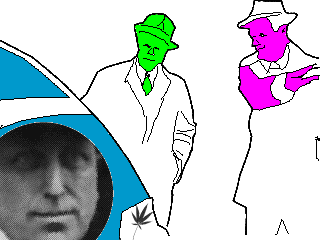
Henry Ford: 1863 - 1947
| HEMPOLOGY.ORG: THE STUDY OF HEMP
|
|||
|
|
||

Pioneering automotive engineer Henry Ford held many patents on
automotive mechanisms, but is best remembered for helping devise
the factory assembly approach to production that revolutionized
the auto industry by greatly reducing the time required to assemble
a car.
Born in Wayne County, Michigan, Ford showed an early interest in mechanics, constructing his first steam engine at the age of 15. In 1893 he built his first internal combustion engine, a small one-cylinder gasoline model, and in 1896 he built his first automobile.
In June 1903 Ford helped establish Ford Motor Company. He served as president of the company from 1906 to 1919 and from 1943 to 1945.
In addition to earning numerous patents on auto mechanisms, Ford served as a vice president of the Society of Automotive Engineers when it was founded in 1905 to standardize U.S. automotive parts. 1
Fuel of the Future
When Henry Ford told a New York Times reporter that ethyl alcohol was "the fuel of the future" in 1925, he was expressing an opinion that was widely shared in the automotive industry. "The fuel of the future is going to come from fruit like that sumach out by the road, or from apples, weeds, sawdust -- almost anything," he said. "There is fuel in every bit of vegetable matter that can be fermented. There's enough alcohol in one year's yield of an acre of potatoes to drive the machinery necessary to cultivate the fields for a hundred years."
Ford recognized the utility of the hemp plant. He constructed a car of resin stiffened hemp fiber, and even ran the car on ethanol made from hemp. Ford knew that hemp could produce vast economic resources if widely cultivated.
Ford's optimistic appraisal of cellulose and crop based ethyl alcohol fuel can be read in several ways. First, it can be seen as an oblique jab at a competitor. General Motors had come to considerable grief that summer of 1925 over another octane boosting fuel called tetra-ethyl lead, and government officials had been quietly in touch with Ford engineers about alternatives to leaded gasoline additives. Secondly, by 1925 the American farms that Ford loved were facing an economic crisis that would later intensify with the depression. Although the causes of the crisis were complex, one possible solution was seen in creating new markets for farm products. With Ford's financial and political backing, the idea of opening up industrial markets for farmers would be translated into a broad movement for scientific research in agriculture that would be labelled "Farm Chemurgy." 2
Why Henry's plans were delayed for more than a half century:
Ethanol has been known as a fuel for many decades. Indeed, when Henry Ford designed the Model T, it was his expectation that ethanol, made from renewable biological materials, would be a major automobile fuel. However, gasoline emerged as the dominant transportation fuel in the early twentieth century because of the ease of operation of gasoline engines with the materials then available for engine construction, a growing supply of cheaper petroleum from oil field discoveries, and intense lobbying by petroleum companies for the federal government to maintain steep alcohol taxes. Many bills proposing a National energy program that made use of Americas vast agricultural resources (for fuel production) were killed by smear campaigns launched by vested petroleum interests. One noteworthy claim put forth by petrol companies was that the U.S. government's plans "robbed taxpayers to make farmers rich".
Gasoline had many disadvantages as an automotive resource. The "new" fuel had a lower octane rating than ethanol, was much more toxic (particularly when blended with tetra-ethyl lead and other compounds to enhance octane), generally more dangerous, and contained threatening air pollutants. Petroleum was more likely to explode and burn accidentally, gum would form on storage surfaces and carbon deposits would form in combustion chambers of engines. Pipelines were needed for distribution from "area found" to "area needed". Petroleum was much more physically and chemically diverse than ethanol, necessitating complex refining procedures to ensure the manufacture of a consistent "gasoline" product.
However, despite these environmental flaws, fuels made from petroleum have dominated automobile transportation for the past three-quarters of a century. There are two key reasons: First, cost per kilometer of travel has been virtually the sole selection criteria. Second, the large investments made by the oil and auto industries in physical capital, human skills and technology make the entry of a new cost-competitive industry difficult.
Until very recently, environmental concerns have been largely ignored. All of that is finally changing as consumers demand fuels such as ethanol, which are much better for the environment and human health.3
References:
The above information graciously provided by Hemp Car Transamerica: HEMPCAR.ORG
Pubdate: November, 1999
Source: Audobon Magazine. Excerpt from an article entitled "Legalize
It!"
Author: Ted Williams
. . .
Practically anything we make from a polluting, nonrenewable hydrocarbon like oil or coal can be made from a relatively clean, renewable carbohydrate like hemp. Henry Ford used to preach this in the 1940s. "Why use up the forests, which were centuries in the making, and the mines, which required ages to lay down, if we can get the equivalent of forests and mineral products in the annual growth of the fields?" he asked. Ford, who had a vision of "growing automobiles from the soil," even produced a demonstration model with body parts partially made with hemp.
Read the entire article:
http://magazine.audubon.org/incite/incite9911.html
Pubdate: November, 1990
Source: ABC News, New York
Author: Hugh Downs
Excerpt from transcript of commentary on hemp
. . .
In the 1930s the Ford Motor Company also saw a future in biomass fuels. Ford operated a successful biomass conversion plant, that included hemp, at their Iron Mountain facility in Michigan. Ford engineers extracted methanol, charcoal fuel, tar, pitch, ethyl-acetate and creosote. All fundamental ingredients for modern industry and now supplied by oil-related industries.
The difference is that the vegetable source
is renewable, cheap and clean, and the petroleum or coal sources
are limited, expensive and dirty. By volume, 30% of the hemp seed
contains oil suitable for high-grade diesel fuel as well as aircraft
engine and precision machine oil.
Henry Ford's experiments with methanol promised cheap, readily
renewable fuel. And if you think methanol means compromise, you
should know that many modern race cars run on methanol.
Read the entire commentary:
http://www.druglibrary.org/schaffer/hemp/downs2.htm
Pubdate: May 29, 1997
Source: Knight-Ridder/Tribune Business News
Henry Ford once built automobile fenders and doors from industrial hemp, saying they were stronger than sheet metal.
Read the entire article:
http://www.scn.org/~bc616/ford
